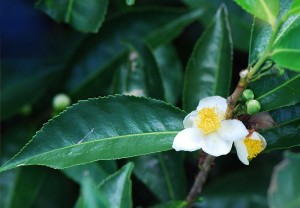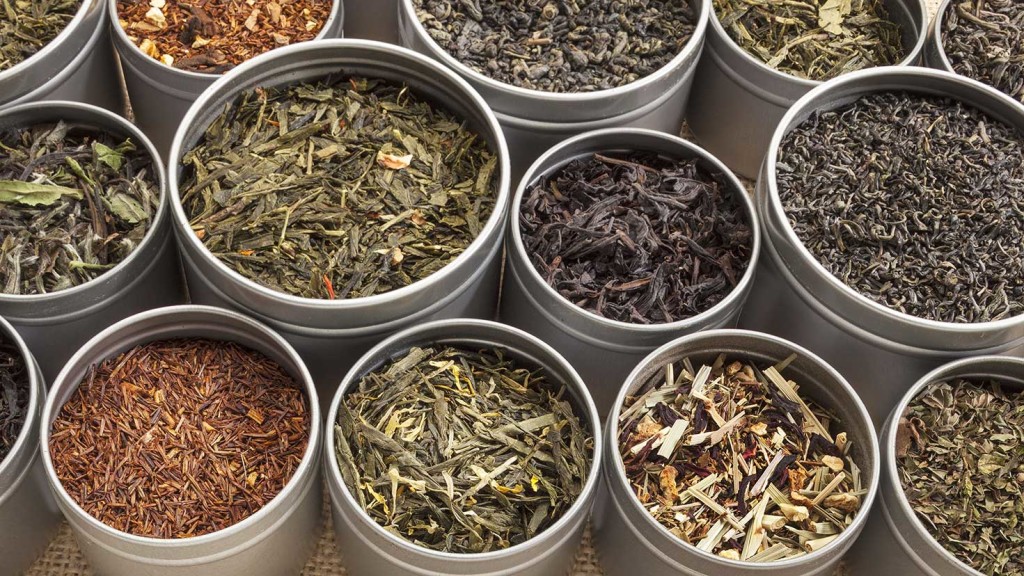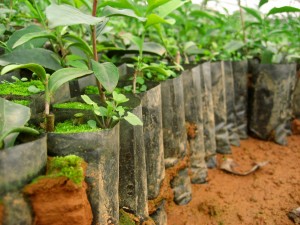Camellia sinensis is a woody, evergreen shrub that produces white or yellow flowers. It is a perennial and can live up to 100 years. It is part of the Theacea family, which is home to all plant species used for tea. The family is known for its 5 sepals and petals. For thousands of years, this plant has been cultivated for the use of making a medicinal and social drink. The shrub to a tree size at 17 meters, but it is usually trimmed to be 1-2 meters for ease of tea harvest. The top two leaves and bud are hand harvested for high quality tea. Faster harvested known as ‘course plucking’ involved harvesting the top three leaves and bud. These buds are picked every one to two weeks. In recent years, some areas such as Japan have adopted mechanical harvesting for teabag production.
Camellia sinensis is native to Southeast Asia, East Asia, and areas in India. Though today, they can be found cultivated around the world in about 30 countries. C. sinensis prefers wet, humid climates with at least 50 inches of rainfall a year. Regions that have monsoon seasons are most common tea growing areas because of the favorable conditions left for the hearty shrubs. These plants grow well on high slopes, allowing adequate drainage. In areas such as China, low rainfall in the winter allows for strong roots that are much less susceptible root rot than other, more tropical growing areas. This break in water income allows the plant to go into dormancy and produce fresh, soft buds with the first rainfalls in spring. Thriving at elevations above 9,500 feet, the highlands in China and India are idea growing environments. C. sinensis prefers slightly acidic soils, ideal levels are from 4-5.6 pH. This can only be true with solid water holding capacity as well. 
All types of tea are harvested at the same time, the processing is what changes the flavor of eat tea. Camellia sinensis is used to make green, black, yellow, and white teas. Green, black and oolong teas are highest in production, and have created the highest demand in the tea growing industry. Green tea is produced by omitting the oxidation process other tea varieties go through. Oxidation is highly promoted in black tea production, allowing almost all green leaf polyphenols are oxidized. Oolong tea is a variety less intensely oxidized. Less than 2% of all tea produced is oolong, while green tea only accounts for 20% of overall production. Green tea is consumed primarily in China, Japan, and a few countries in North Africa and the Middle East.
The most common propagation methods today involve single nod cuttings. This conventional propagation is slow, and over time slowly shortens the plant’s genetic base. Traditionally, seed planting has been most common. Seeds germinate in the sun and once seedlings reach a strong stage they are transplanted to pots. These seedlings will not be ready to plant in the field until they are two to three years old. Recently, a lot of research has been put into new, more effective methods. In vitro is the hot new propagation method out today that would in theory be less expensive. Mircopropagation requires less labor and has a much higher success rate. Though, the current conventional cuttings are less expensive because they can be completed with limited resources and in remote areas. Conventional one-node plant cultivation is much faster than traditional seed planting, only taking one year before reaching size to be planted in field. These are also much more uniform than seed planting. To create successful cuttings, one must provide the perfect acidity. A pH of 7 would lead to slowed growth and a high probability of death within the first year in the field. Cultivators have been adding sulpur or aluminum sulphate to ensure the high acidity. Elemental sulphor that is added to soil must be broken down by microorganisms. If this process is not perfectly timed it can result in damaged roots from toxic forms of sulpur not yet broken down. Recent studies have shown that aluminum sulphate, even in high concentrations, does not negatively effect plant growth.
Currently, arthropods are the biggest insect pest risk to Camellia sinensis around the world. Over one thousand species of arthropods have been reported to cause some form of damage to monocultured plantations. These insects feed on the roots, leaves, shoots, flowers, seeds, and stems of C. sinensis, leaving the tea plant helpless in an invasion. Pesticide use has been yet to be effect in killing the pathogen as well as continuing to produce a clean tasting tea beverage. Blight is also a highly damaging pathogen that is common on Camellia sinensis grown in high humidity areas. Blights are housed in areas with low air flow. Once the plants have been infected, it is very difficult to stop blight from spreading incredibly quickly among a plantation. Scale,aphids, and mites are all common pathogens that feed on the leaves of c. sinensis. Most of theses populations cause damage that is nearly impossible to reverse. Some aphid populations can only be removed by hand, creating an unrealistic IPM for large scale farms.
Written by: Nikki


